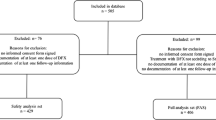Abstract
Many patients with bone marrow failure syndromes need frequent transfusions of red blood cells, and most of them eventually suffer from organ dysfunction induced by excessively accumulated iron. The only way to treat transfusion-induced iron overload is iron chelating therapy. However, most patients have not been treated effectively because daily/continuous administration of deferoxamine is difficult for outpatients. Recently, a novel oral iron chelator, deferasirox, has been developed, and introduction of the drug may help many patients benefit from iron chelation therapy. In this review, we will discuss the current status of iron overload in transfusion-dependent patients, and the development of Japanese guidelines for the treatment of iron overload in Japan, which were established by the National Research Group on Idiopathic Bone Marrow Failure Syndromes in Japan.



Similar content being viewed by others
References
Kushner JP, Porter J, Olivieri N. Secondary iron overload. Hematology/American Society of Hematology Education Program Book: American Society of Hematology; 2001.
McLaren GD, Muir WA, Kellermeyer RW. Iron overload disorders: natural history, pathogenesis, diagnosis, and therapy. Crit Rev Clin Lab Sci. 1983;19:205–66.
Takatoku M, Uchiyama T, Okamoto S, et al. Retrospective nationwide survey of Japanese patients with transfusion-dependent MDS and aplastic anemia highlights the negative impact of iron overload on morbidity/mortality. Eur J Haematol. 2007;78:487–94.
Shashaty G, Frankewich R, Chakraborti T, et al. Deferasirox for the treatment of chronic iron overload in transfusional hemosiderosis. Oncology (Williston Park). 2006;20:1799–806, 1811; discussion 1811–3, 1817.
Malcovati L, Porta MG, Pascutto C, et al. Prognostic factors and life expectancy in myelodysplastic syndromes classified according to WHO criteria: a basis for clinical decision making. J Clin Oncol. 2005;23:7594–603.
Gattermann N, Porter J, Lopes L, Seymour J. Consensus statement on iron overload in myelodysplastic syndromes. Hematol Oncol Clin North Am. 2005;19:18–25.
Di Tucci AA, Murru R, Alberti D, Rabault B, Deplano S, Angelucci E. Correction of anemia in a transfusion-dependent patient with primary myelofibrosis receiving iron chelation therapy with deferasirox (Exjade, ICL670). Eur J Haematol. 2007;78:540–42.
Jensen PD, Heickendorff L, Pedersen B, et al. The effect of iron chelation on haemopoiesis in MDS patients with transfusional iron overload. Br J Haematol. 1996;94:288–99.
Piga A, Galanello R, Forni GL, et al. Randomized phase II trial of deferasirox (Exjade, ICL670), a once-daily, orally-administered iron chelator, in comparison to deferoxamine in thalassemia patients with transfusional iron overload. Haematologica. 2006;91:873–80.
Cappellini MD, Cohen A, Piga A, et al. A phase 3 study of deferasirox (ICL670), a once-daily oral iron chelator, in patients with beta-thalassemia. Blood. 2006;107:3455–62.
Porter J, Vichinsky E, Rose C, et al. A phase II study with ICL670 (Exjade), a once-daily oral iron chelator, in patients with various transfusion-dependent anemias and iron overload. Blood. 2004;104:abstract 3193.
Alessandrino EP, Amadori S, Barosi G, et al. Evidence- and consensus-based practice guidelines for the therapy of primary myelodysplastic syndromes. A statement from the Italian Society of Hematology. Haematologica. 2002;87:1286–306.
Bowen D, Culligan D, Jowitt S, et al. Guidelines for the diagnosis and therapy of adult myelodysplastic syndromes. Br J Haematol. 2003;120:187–200.
Greenberg PL, Baer MR, Bennett JM, et al. Myelodysplastic syndromes clinical practice guidelines in oncology. J Natl Compr Canc Netw. 2006;4:58–77.
Acknowledgments
This work was supported by a grant (Research on Intractable Diseases) from the Ministry of Health, Labor and Welfare of Japan. The authors thank Dr. Norbert Gattermann for his valuable advice in establishing the guidelines.
Author information
Authors and Affiliations
Corresponding author
About this article
Cite this article
Suzuki, T., Tomonaga, M., Miyazaki, Y. et al. Japanese epidemiological survey with consensus statement on Japanese guidelines for treatment of iron overload in bone marrow failure syndromes. Int J Hematol 88, 30–35 (2008). https://doi.org/10.1007/s12185-008-0119-y
Received:
Accepted:
Published:
Issue Date:
DOI: https://doi.org/10.1007/s12185-008-0119-y




